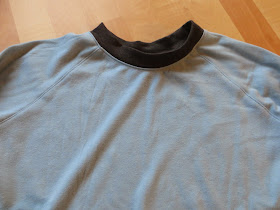After making this vest, this company is my new current favourite. I spent a lot of time thinking about the Dropje. Carrie's double-sided version seemed very shapeless, and I suspected I wanted something more fitted. I had some (highly unrealistic) ideas about skiing around in this vest on well-groomed ski slopes, but we have had almost no snow this year, *and* I never "ski around," I whimper and cry and then do everything possible to avoid actually facing downward on a ski slope, so I'm not completely sure what I'll wear it for.
I asked my friend R if she would volunteer as a muslin-recipient. The fabric is a scrap from my Georgia dress last year, and I searched high and low for bright pink fleece, but didn't find any. The lining is the fuzzy inside of sweatshirting that I got in Chur. I made a size 34, as R is small. I didn't make any changes to the pattern. After what felt like a lot of thinking about the pattern, construction was amazing. The instructions are fun and straightforward and they made a beautiful finish possible. I enjoyed the construction a lot, and it made me want to try other Waffle patterns (I have the Caramel but am daunted by the long instructions and by making more welt pockets.)
In order to make the lining, I copied all body pieces and only the armhole facings. I attached the hoods right sides together, after sewing both jacket and lining according to the directions (no pockets in the lining!) Then I sandwiched the zipper between the layers to get a clean zip finish. I suspect that I could have then sewn the armholes together...but instead I basted them and used the armhole facing. Finally I folded the hem over the lining and sewed (mostly) in the ditch for a clean finish. I got excited near the end (cause I wanted to mail it to R!) and my sewing in the ditch was all over the place.
Interestingly enough, it fits me ok. I would have made a size 38 going by the chart. I will shorten it by 1" for me, but I'm debating whether to make the same size, or a 36 for some extra room. I tried it on with a sweatshirt underneath and it was still fine. However, I want to make a quilted version. The fabric I'm planning to use is flannel and wool tweed, which don't have the stretch of the cotton. I have read that quilting shrinks fabric, so to avoid that I thought I would quilt before cutting out the pattern pieces. Originally I was going to quilt the lining and the exterior together, but the lining on R's jacket is sooo nice as it is, and that clean finish is great. It makes me consider just quilting one layer - but the outside, or the inside?
I asked my friend R if she would volunteer as a muslin-recipient. The fabric is a scrap from my Georgia dress last year, and I searched high and low for bright pink fleece, but didn't find any. The lining is the fuzzy inside of sweatshirting that I got in Chur. I made a size 34, as R is small. I didn't make any changes to the pattern. After what felt like a lot of thinking about the pattern, construction was amazing. The instructions are fun and straightforward and they made a beautiful finish possible. I enjoyed the construction a lot, and it made me want to try other Waffle patterns (I have the Caramel but am daunted by the long instructions and by making more welt pockets.)
In order to make the lining, I copied all body pieces and only the armhole facings. I attached the hoods right sides together, after sewing both jacket and lining according to the directions (no pockets in the lining!) Then I sandwiched the zipper between the layers to get a clean zip finish. I suspect that I could have then sewn the armholes together...but instead I basted them and used the armhole facing. Finally I folded the hem over the lining and sewed (mostly) in the ditch for a clean finish. I got excited near the end (cause I wanted to mail it to R!) and my sewing in the ditch was all over the place.
Interestingly enough, it fits me ok. I would have made a size 38 going by the chart. I will shorten it by 1" for me, but I'm debating whether to make the same size, or a 36 for some extra room. I tried it on with a sweatshirt underneath and it was still fine. However, I want to make a quilted version. The fabric I'm planning to use is flannel and wool tweed, which don't have the stretch of the cotton. I have read that quilting shrinks fabric, so to avoid that I thought I would quilt before cutting out the pattern pieces. Originally I was going to quilt the lining and the exterior together, but the lining on R's jacket is sooo nice as it is, and that clean finish is great. It makes me consider just quilting one layer - but the outside, or the inside?






































